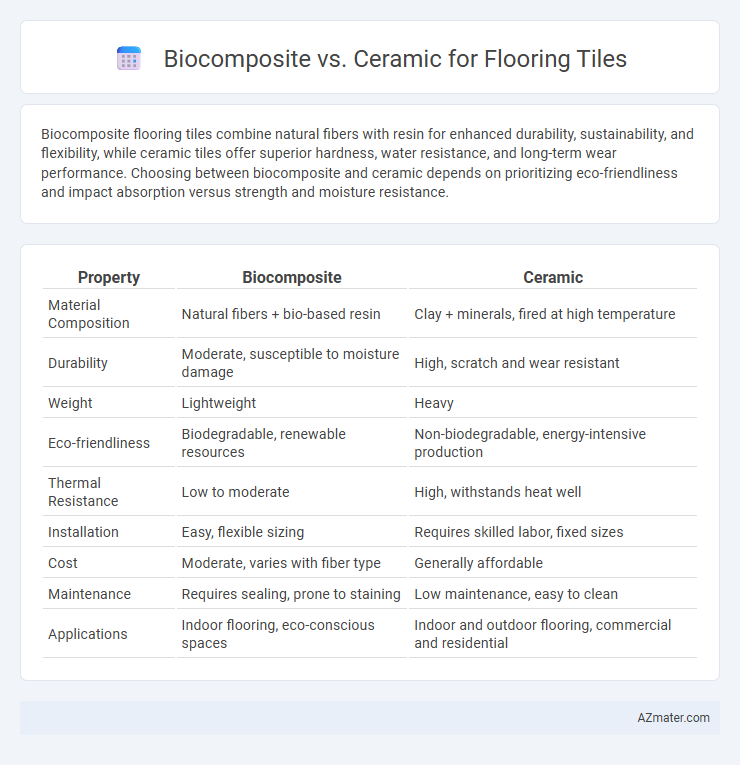Biocomposite flooring tiles combine natural fibers with resin for enhanced durability, sustainability, and flexibility, while ceramic tiles offer superior hardness, water resistance, and long-term wear performance. Choosing between biocomposite and ceramic depends on prioritizing eco-friendliness and impact absorption versus strength and moisture resistance.
Table of Comparison
| Property | Biocomposite | Ceramic |
|---|---|---|
| Material Composition | Natural fibers + bio-based resin | Clay + minerals, fired at high temperature |
| Durability | Moderate, susceptible to moisture damage | High, scratch and wear resistant |
| Weight | Lightweight | Heavy |
| Eco-friendliness | Biodegradable, renewable resources | Non-biodegradable, energy-intensive production |
| Thermal Resistance | Low to moderate | High, withstands heat well |
| Installation | Easy, flexible sizing | Requires skilled labor, fixed sizes |
| Cost | Moderate, varies with fiber type | Generally affordable |
| Maintenance | Requires sealing, prone to staining | Low maintenance, easy to clean |
| Applications | Indoor flooring, eco-conscious spaces | Indoor and outdoor flooring, commercial and residential |
Introduction to Flooring Tile Materials
Biocomposite flooring tiles combine natural fibers such as hemp, flax, or coconut with biodegradable resins to create sustainable, eco-friendly options that offer flexibility and thermal insulation. Ceramic tiles, made from clay and minerals fired at high temperatures, provide exceptional durability, water resistance, and a wide range of design possibilities. Both materials serve distinct functional and aesthetic needs in flooring applications, influencing choices based on environmental impact, maintenance, and longevity.
What are Biocomposite Tiles?
Biocomposite tiles are flooring materials made from a combination of natural fibers, such as wood or agricultural residues, and bio-based resins, resulting in an eco-friendly alternative to traditional ceramic tiles. These tiles offer enhanced flexibility, lighter weight, and improved thermal insulation compared to ceramic options. Their sustainable composition reduces environmental impact while providing durability and aesthetic versatility for various flooring applications.
Overview of Ceramic Tiles
Ceramic tiles are composed primarily of natural clay and minerals, fired at high temperatures to create a durable, water-resistant surface ideal for flooring applications. These tiles offer exceptional hardness, stain resistance, and low porosity, making them suitable for high-traffic areas and wet environments. Their wide range of colors, textures, and finishes provides versatile design options that enhance both residential and commercial spaces.
Eco-Friendliness: Biocomposite vs Ceramic
Biocomposite flooring tiles are highly eco-friendly due to their use of renewable natural fibers combined with biodegradable resins, significantly reducing environmental impact and carbon footprint. Ceramic tiles, while durable and recyclable, require high-energy manufacturing processes involving mining and firing at extreme temperatures, leading to greater resource depletion and greenhouse gas emissions. Choosing biocomposite over ceramic flooring supports sustainable building practices by promoting renewable materials and lower energy consumption throughout the product lifecycle.
Durability and Longevity Comparison
Biocomposite flooring tiles offer impressive durability with enhanced resistance to impacts, moisture, and wear due to their engineered resin and natural fiber blend, promoting long-term performance in both residential and commercial settings. Ceramic tiles excel in hardness and scratch resistance, providing exceptional longevity especially in high-traffic areas, but they can be brittle and prone to cracking under heavy impact. The choice between biocomposite and ceramic tiles depends on the balance between flexibility and toughness versus hardness and potential fragility, with biocomposites better resisting deformation and ceramics offering superior lifespan in optimal conditions.
Aesthetic Versatility in Design
Biocomposite flooring tiles offer superior aesthetic versatility compared to ceramic tiles, featuring a wide range of customizable colors, textures, and patterns that mimic natural materials like wood and stone. Ceramic tiles are often limited to glazed finishes with uniform designs, making biocomposites ideal for innovative and eco-friendly interior spaces. The adaptability of biocomposites supports diverse design styles from modern minimalism to rustic charm, enhancing creative expression in flooring applications.
Installation and Maintenance Requirements
Biocomposite flooring tiles offer easier installation due to their lightweight nature and flexibility, allowing for quick cutting and fitting with basic tools, while ceramic tiles require precise cutting tools and professional grout application for proper placement. Maintenance for biocomposite tiles involves routine cleaning with mild detergents and occasional sealing to prevent moisture damage, whereas ceramic tiles demand less frequent sealing but require grout maintenance to prevent staining and mold growth. Both materials provide durability, but biocomposites excel in ease of handling during installation and maintenance simplicity in wet or high-traffic areas.
Cost Analysis and Market Availability
Biocomposite flooring tiles generally offer a lower cost compared to ceramic tiles due to cheaper raw materials like natural fibers and resins, making them an economical choice for sustainable building projects. Ceramic tiles, while often more expensive upfront, provide widespread market availability and durability, with a well-established supply chain across global markets. Market data shows ceramic tiles dominate with approximately 60% of the flooring tile market share, whereas biocomposite tiles are rapidly growing in niche eco-friendly segments but currently represent under 10% of overall market availability.
Performance in Different Environments
Biocomposite flooring tiles offer superior flexibility and moisture resistance, making them ideal for humid or fluctuating climate conditions, while ceramic tiles excel in hardness and thermal stability, which benefits high-traffic and heat-exposed environments. Biocomposites provide better impact absorption and thermal insulation, contributing to comfort in residential applications, whereas ceramics resist abrasion and chemical exposure, enhancing durability in commercial and industrial settings. Choosing between biocomposite and ceramic flooring depends on the specific environmental stresses, such as moisture levels, temperature variations, and foot traffic intensity, to optimize long-term performance.
Choosing the Right Tile: Biocomposite vs Ceramic
Biocomposite flooring tiles offer eco-friendly benefits with enhanced flexibility and resistance to impact, making them ideal for sustainable building projects and residential areas requiring comfort underfoot. Ceramic tiles excel in durability, water resistance, and ease of maintenance, suitable for high-traffic commercial spaces and humid environments like kitchens and bathrooms. Choosing the right tile depends on prioritizing sustainability and comfort in biocomposites or durability and moisture resistance provided by ceramic tiles.

Infographic: Biocomposite vs Ceramic for Flooring Tile
 azmater.com
azmater.com